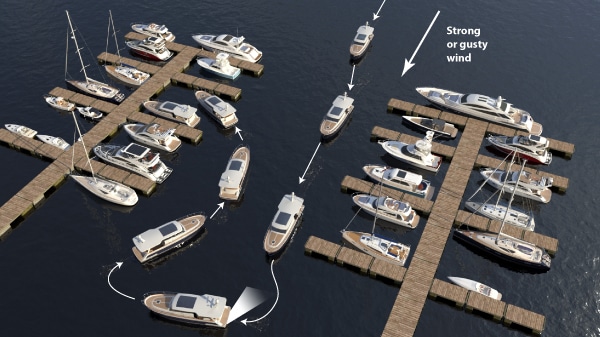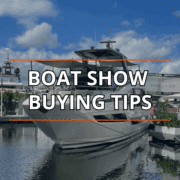Get started with powerboating with NauticEd’s FREE online Navigation Rules for Powerboats, or become a competent powerboater with the Skipper Large Powerboat Course – a comprehensive online powerboating course for beginner to intermediate powerboaters wanting to learn how to operate larger powerboats greater than 26ft. Or upgrade to the Bareboat Charter Master for Powerboats Bundle of online courses to also master multiday and near-coastal powerboating as well as charter powerboats on vacations.
Boat Buying 101: A Process, Not a Purchase
Buying a boat isn’t like picking up a new gadget or a car—it’s a project. A serious one. The kind of project that, if done well, can bring you a lifetime of adventure. But if rushed or mismanaged, can turn into a floating regret. Here’s how to go about it the right way.
Step 1: Define the Mission
Before you even start looking at boats, take a long, honest look at yourself. What do you want this boat to do?
- Are you crossing oceans or poking around local coves?
- Weekend trips or full-time liveaboard life?
- Do you want to fish? Host friends? Watch sunrises in quiet anchorages?
- Will you be the one maintaining it—or are you hiring that out?
- Where will it live? Marina, mooring, trailer?
Every answer narrows the field. And this isn’t just about features—it’s about your lifestyle, your values, and your capacity. Define the deliverables before you shop for the solution.
Step 2: Research Like a Maniac
This is where the real work begins. And yes, it’s work.
- Read everything—forums, magazines, books.
- Walk docks. Go to boat shows. Charter boats. Ask questions.
- Make a spreadsheet. (You’ll thank yourself later.)
- Compare real boats to your list of must-haves and nice-to-haves.
- Develop a feel for the market. Track pricing trends, layouts, and engine configs.
Don’t just read about boats—get on them. Charter one. Sit in the galley. Lie in the stateroom. Open the fridge and ask: could we actually live like this?
Step 3: Know What You’ll Compromise On
You won’t get everything. No one does. But the smart buyers are the ones who walk in knowing what matters most—and what can be let go.
Maybe you always thought you wanted a pilothouse, until you were on one and realized it wasn’t a dealbreaker. Maybe you discover galley-up layouts work way better for how you cook and hang out.
Some compromises won’t feel like sacrifices if you’ve done the groundwork. And when you see “the one,” you’ll know.
Step 3: Know What You’ll Compromise On
You won’t get everything. No one does. But the smart buyers are the ones who walk in knowing what matters most—and what can be let go.
Maybe you always thought you wanted a pilothouse, until you were on one and realized it wasn’t a dealbreaker. Maybe you discover galley-up layouts work way better for how you cook and hang out.
Some compromises won’t feel like sacrifices if you’ve done the groundwork. And when you see “the one,” you’ll know.
Step 4: Filter Ruthlessly
Use your checklist. Go through boats like you’re evaluating a business system.
- Does it meet your essential needs?
- Does it match your cruising grounds?
- Can it handle your storage, dinghy setup, or bad back?
- Is it the right balance of size, complexity, and cost?
You’ll be amazed how fast your options narrow once you’re honest with yourself.
Step 5: Feel It Out
At some point, numbers and specs give way to something else—feel.
Does this boat just feel right?
Charter one if you can. Ride on it. Talk to owners. There’s no substitute for putting yourself in the experience. A boat isn’t just a product—it’s a lifestyle. You don’t buy a boat; you start a relationship with it.
Step 6: The Offer, the Test, the Leap
Once you’ve found the right match:
- Make the offer.
- Sea trial. Survey.
- Renegotiate if needed.
Even here, there’s an emotional threshold to cross. It’s not just dollars—it’s deciding that this boat fits you and your partner. It’s mutual. And yes, it will probably feel scary. That’s normal.
Bonus Wisdom: The Real Questions
- What’s the smallest boat you can live on? Not the biggest you can afford.
- Where are you really going to go?
- What are you like when it comes to maintenance, storage, and projects?
- What do you really not want? Sometimes the “no” list is longer than the “yes” list.
And remember: almost everyone upsizes eventually. Whatever seems big now will feel smaller later. That’s just how this works.
Final Thought: Trust the Process
- Boat buying is a journey. It’s not just about picking a hull—it’s about understanding yourself.
Skip steps, and you’ll likely regret it. Follow the process, and even if things go sideways, you’ll know you made the best choice you could. And that, more than anything, is what leads to satisfaction on the water.
So do the work. Ask the questions. Take the time. The right boat is out there—but only if the right you is doing the looking.

Get started with powerboating with NauticEd’s FREE online Navigation Rules for Powerboats, or become a competent powerboater with the Skipper Large Powerboat Course – a comprehensive online powerboating course for beginner to intermediate powerboaters wanting to learn how to operate larger powerboats greater than 26ft. Or upgrade to the Bareboat Charter Master for Powerboats Bundle of online courses to also master multiday and near-coastal powerboating as well as charter powerboats on vacations.





